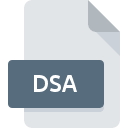.DSA File Extension

DAZ Studio 3+ Script
| Developer | DAZ Productions |
| Popularity | |
| Category | 3D Image Files |
| Format | .DSA |
| Cross Platform | Update Soon |
What is an DSA file?
The .DSA file extension is associated with DAZ Studio, a popular 3D modeling and animation software developed by DAZ 3D.
DAZ Studio allows users to create complex 3D scenes, animations, and digital art. The .DSA file extension specifically represents DAZ Studio Scripts, which are written in the DAZ Script Language (DSL).
These scripts extend the functionality of DAZ Studio, enabling automation of tasks, custom user interfaces, and the implementation of advanced features.
More Information.
DAZ Studio’s introduction of scripting capabilities marked a significant advancement in the software’s evolution.
Initially, DAZ Studio provided a graphical interface for 3D modeling and rendering but lacked the flexibility that scripting offers.
The introduction of .DSA files allowed users to write custom scripts to manipulate objects, control animations, and manage scenes programmatically.
Initially, the purpose of .DSA files was to provide a way for users to automate routine tasks, such as batch processing of files or repetitive scene adjustments.
Over time, their use expanded to include more complex functionalities, such as creating new tools within DAZ Studio, automating character rigging, and developing custom interfaces that improve user interaction with the software.
Origin Of This File.
The .DSA file extension was introduced by DAZ 3D as part of its scripting capabilities within DAZ Studio. DAZ Studio, initially released in 2005, evolved to include scripting support in later versions to enhance its versatility and provide users with more control over their 3D projects.
The .DSA files are created to streamline workflows and enable users to customize their DAZ Studio experience by writing scripts that automate repetitive tasks, create new tools, or extend the application’s functionality.
File Structure Technical Specification.
.DSA files are essentially plain text files written in DAZ Script Language (DSL), a proprietary scripting language developed by DAZ 3D.
The DSL language is designed specifically for use within DAZ Studio and provides a range of functions and commands to interact with the software’s API (Application Programming Interface).
The structure of a .DSA file typically includes:
- Script Header: This section contains metadata about the script, such as its name, author, and version. It may also include comments or instructions.
- Initialization Code: Code that sets up the initial state of the script, including variable declarations and setup procedures.
- Main Logic: The core of the script, where the primary functions and commands are executed. This includes manipulating 3D objects, adjusting scene settings, or handling user inputs.
- Functions and Procedures: Custom functions or procedures defined by the script author to perform specific tasks or operations.
- Error Handling: Code to handle any errors or exceptions that may occur during script execution, ensuring smooth operation and user feedback.
A .DSA file is saved in plain text format, making it easy to read and edit with any text editor. The file can be executed within DAZ Studio to perform the actions defined in the script.
How to Convert the File?
Converting a .DSA file to another format is generally unnecessary since .DSA files are specifically designed for use within DAZ Studio.
If you need to share or utilize script content outside DAZ Studio, you can manually copy the script code from the .DSA file and paste it into a text editor or other scripting environment.
If you need to convert the script to another scripting language or format, you would need to manually translate the DSL code into the target language or format, taking into account any differences in syntax or functionality.
Advantages And Disadvantages.
Advantages:
- Customization: .DSA files allow users to tailor DAZ Studio to their specific needs by automating tasks and creating custom tools. This can significantly enhance productivity and efficiency.
- Automation: Repetitive tasks, such as batch processing of assets or adjusting multiple scene elements, can be automated using scripts, saving time and reducing manual effort.
- Flexibility: Scripts can be modified and updated as needed, providing a flexible solution for adapting to changing project requirements or workflow improvements.
- Extended Functionality: By writing scripts, users can extend DAZ Studio’s capabilities beyond its default features, adding new functionalities or integrating with other software.
Disadvantages:
- Complexity: Writing and debugging scripts can be complex and may require a good understanding of DAZ Script Language (DSL) and DAZ Studio’s API.
- Learning Curve: Users unfamiliar with scripting may face a steep learning curve when trying to create or modify .DSA files, requiring time and effort to master the necessary skills.
- Compatibility Issues: Scripts written for one version of DAZ Studio may not always be compatible with other versions, leading to potential issues when updating or sharing scripts.
- Potential for Errors: Poorly written scripts or errors in the script code can cause unexpected behavior or crashes within DAZ Studio, impacting the user experience.
How to Open DSA?
Open In Windows
- Use text editors like Notepad, Notepad++, or Sublime Text. Right-click the .DSA file, select “Open with,” and choose your preferred text editor.
Open In Linux
- Use text editors like Gedit, Nano, or Vim. Right-click the .DSA file and choose to open it with your preferred editor or use the command line to open it with a text-based editor.
Open In MAC
- Use text editors such as TextEdit, Sublime Text, or Visual Studio Code. Right-click the .DSA file, select “Open With,” and choose the text editor you prefer.












